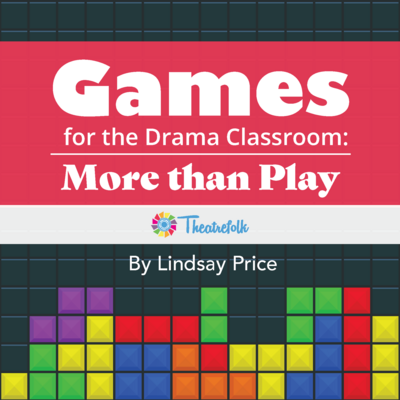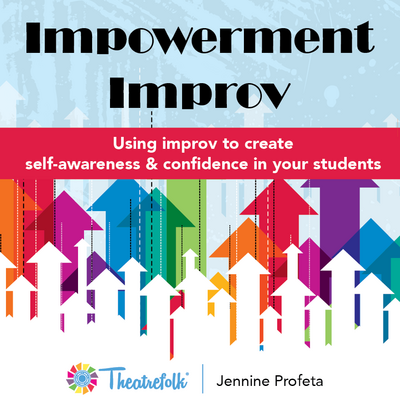A squirt gun would never be mistaken for a real gun, right? Dive into the thought-provoking world of Water. Gun. Argument and challenge what we choose to believe. A thought provoking and powerful piece in a docu-theatre style.
Top 5 tips for Adapting Improv for a Virtual Performance
Jim Hoare is the author ofYour High School Improv Show Playbook and has added a Virtual Performance Pandendum (Pandemic Addendum) to the resource for adapting improv to a virtual environment. For those of you looking to put on a virtual Improv show, here are his top five tips and games suggestions!
1. Practice, Practice, Practice
Experiment with different formats to see which serves you best. If, after trying a virtual improv show on a platform (Zoom, StreamYard), or recording and editing a short improv show for scheduled streaming, you feel that the quality is not something you are proud to share with your community, don’t stream that performance. Consider it a valuable learning experience and try again. The goal is education, not TV ratings. Share what you are proud to share.
2. Lighting
You must light the show for the video stream, not the theater, otherwise it may be too dark for those watching at home. You can do this either by adding more light to your performance space or by using a video camera with the ability to adjust to low-light. For those improvisors performing at home, it means having light on their face and not bright light behind them, which will make their face difficult to see.
3. Face Masks
Good sound is key. With a socially distanced cast wearing face masks, diction, articulation, and projection are more important than ever. Use face masks as a teaching tool/aid to help students improve in these areas. Warm up with tongue-twisters and articulation exercises. When the face masks finally come off, their diction, articulation, and projection will be better because of it. For those improvisors at home, diction, articulation, and projection are just as important. Before streaming your show, ask someone who was not involved in the filming or editing to watch and listen to the finished product. If they cannot clearly understand what is being said, start over.
4. Social Distancing
If gathering actors in person, tape safe distancing boxes on the stage. However, students who live together, or who have been exclusively socializing together since March, with parents’ permission, may be able to perform together and stand closer on stage. Consider “Cohort Casting” for some group games.
5. Set Clear Expectations
Set clear goals and expectations for online meetings with parents and students. Before your virtual improv show, set clear goals and expectations with your audience. “What you are about to see is something completely new. It’s not our usual improv show at school – and it’s not the next episode of Whose Line Is It Anyway? It is our best effort to Keep Calm and Carry On With Some Silliness during these challenging days. We hope you enjoy – and we look forward to being back together in person as soon as possible.” (or similar)
Top 5 Improv Games to Play Virtually
Games where individual players speak one at a time lend themselves to online viewing and screen sharing. Those games are more about speaking and less about physicalizing. Rather than move downstage to participate in the game, players raise their hands and unmute themselves or wait to quickly be acknowledged by you.
1. 185 (a game about puns)
The object of the game is to come up with a bad pun that elicits a groan from the audience. Ask the audience to write in chat an occupation or hobby. As soon as the occupation or hobby is announced, any member of the team can step forward (or raise their hands and unmute themselves). The goal is to see how many puns they can come up with in the time given (usually about two minutes). The same person can go more than once.
2. Alphabet Game / A-B-C-prov
Come up with a relationship, a destination, and a means of transportation for two players (mom and son going to college, dad teaching daughter to drive, etc.). Decide which letter of the alphabet the scene will start with. Beginning with that letter and continuing in the order of the alphabet, the players must build a scene within 26 sentences or phrases, with each sentence or phrase starting with the next letter of the alphabet until every letter has been used.
Before you begin, decide how many players will participate (two or more). You may want to establish an order, so that each player knows exactly when they will contribute the next sentence in the conversation (with the next letter of the alphabet). Sentences can be as short as one word or sound (Ahh! Grrh! Zowie!) but avoid run-on sentences which slow the pace of the game.
3. Lines You’re Not Likely to Hear
The whole team will come on stage and be given a person, character, etc. by the host. One at a time, players will step forward (or unmute) to deliver a one-liner demonstrating a line you’re unlikely to hear, from the suggestion.
The goal is to see how many one-liners they can come up with in the time given (usually about two minutes). The same person can go more than once.
4. Thought Dubbing
Four Players – two seen (the characters) and two only heard (their thoughts). Give Player 1 and Player 2 a relationship and a location. Player 3 will voice the thoughts of Player 1 and Player 4 will voice the thoughts of Player 2.
Players 1 and 2 must remember to pause to hear what they are thinking from Players 3 and 4 and then adjust the scene depending on what they are “thinking.” You may want to have Players 3 and 4 hit “Stop Video” on their device so that we only hear them. If so, then Players 3 and 4 must have clear, distinct voices that Players 1 and 2 will recognize as their thoughts.
5. World’s Worst
The whole team will be given a noun, occupation, etc. by the host. One at a time, players will step forward (or unmute) to deliver a one-liner demonstrating the WORST example of the suggestion.
Like Lines You’re Not Likely to Hear, any member of the team can step forward. If the player is at home, encourage the use of props/items or people who may be nearby. This game is about being clear and demonstrative. The same person can go more than once.
Click here to learn more about Your High School Improv Show Playbook
Related Articles
Create Your Own Choice Board: Drama Activities
by Lindsay Price
Choice boards give students the opportunity to choose how they want to learn a particular subject. Create Your Own Choice Boards: Drama Activities can help encourage your students' independence by allowing them to take an active role in their learning.
Distance Learning
by Christian Kiley
A play about trying to survive and thrive in a virtual classroom.
Games for the Drama Classroom: More Than Play
by Lindsay Price
A collection of games and activities that go well beyond the notion of "play."
Improv Games with Purpose
by Jennine Profeta
Improv games including feedback suggestions and questions, game variations, teaching tips, side coaching tips, entry prompts, exit slip questions, and more!
Your High School Improv Show Playbook
by Jim Hoare
Have you wondered how to take improv to the next level with your students? Your High School Improv Show Playbook is the "how-to" guide for you! Empower students to present their first improv show that is fun and entertaining for all.
Impowerment Improv
by Jennine Profeta
Using improv to create self-awareness & confidence in your students





